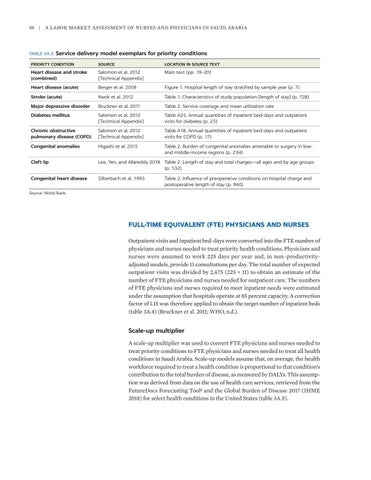58 | A Labor Market Assessment of Nurses and Physicians in Saudi Arabia
TABLE 3A.3 Service
delivery model exemplars for priority conditions
PRIORITY CONDITION
SOURCE
LOCATION IN SOURCE TEXT
Heart disease and stroke (combined)
Salomon et al. 2012 [Technical Appendix]
Main text (pp. 19–20)
Heart disease (acute)
Berger et al. 2008
Figure 1. Hospital length of stay stratified by sample year (p. 7)
Stroke (acute)
Kwok et al. 2012
Table 1. Characteristics of study population [length of stay] (p. 728)
Major depressive disorder
Bruckner et al. 2011
Table 2. Service coverage and mean utilization rate
Diabetes mellitus
Salomon et al. 2012 [Technical Appendix]
Table A25. Annual quantities of inpatient bed-days and outpatient visits for diabetes (p. 25)
Chronic obstructive pulmonary disease (COPD)
Salomon et al. 2012 [Technical Appendix]
Table A18. Annual quantities of inpatient bed-days and outpatient visits for COPD (p. 17)
Congenital anomalies
Higashi et al. 2015
Table 2. Burden of congenital anomalies amenable to surgery in lowand middle-income regions (p. 234)
Cleft lip
Lee, Yen, and Allareddy 2018 Table 2. Length of stay and total charges—all ages and by age groups (p. 532)
Congenital heart disease
Silberbach et al. 1993
Table 2. Influence of preoperative conditions on hospital charge and postoperative length of stay (p. 960)
Source: World Bank.
FULL-TIME EQUIVALENT (FTE) PHYSICIANS AND NURSES Outpatient visits and inpatient bed-days were converted into the FTE number of physicians and nurses needed to treat priority health conditions. Physicians and nurses were assumed to work 225 days per year and, in non–productivity- adjusted models, provide 11 consultations per day. The total number of expected outpatient visits was divided by 2,475 (225 × 11) to obtain an estimate of the number of FTE physicians and nurses needed for outpatient care. The numbers of FTE physicians and nurses required to meet inpatient needs were estimated under the assumption that hospitals operate at 85 percent capacity. A correction factor of 1.15 was therefore applied to obtain the target number of inpatient beds (table 3A.4) (Bruckner et al. 2011; WHO, n.d.).
Scale-up multiplier A scale-up multiplier was used to convert FTE physicians and nurses needed to treat priority conditions to FTE physicians and nurses needed to treat all health conditions in Saudi Arabia. Scale-up models assume that, on average, the health workforce required to treat a health condition is proportional to that condition’s contribution to the total burden of disease, as measured by DALYs. This assumption was derived from data on the use of health care services, retrieved from the FutureDocs Forecasting Tool3 and the Global Burden of Disease 2017 (IHME 2018) for select health conditions in the United States (table 3A.5).

